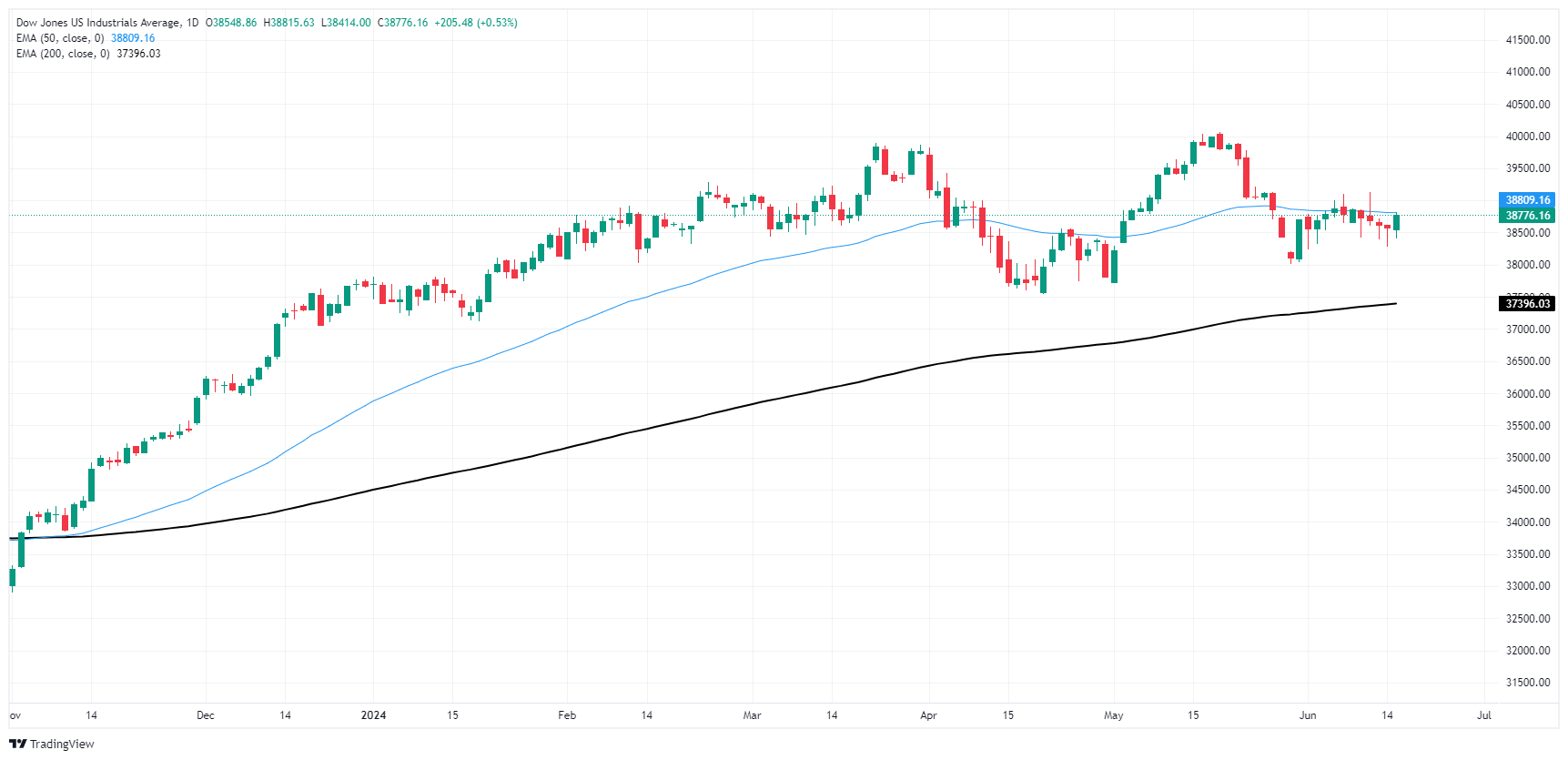Dow Jones Industrial Average gains ground on Monday as sentiment recovers
- Dow Jones clips into higher ground as investors look to claw back territory.
- US Retail Sales to be the early week’s key data print.
- Investors shrug off increasing warnings from Fed policymakers to hope for cuts.
The Dow Jones Industrial Average (DJIA) found thin gains on Monday, climbing four-tenths of a percent as investors recover balance and resume the long wait for rate cuts from the Federal Reserve (Fed). The “bad news is good news” narrative that has fueled investor sentiment seeking an accelerated pace of rate cuts from the Fed still exists in broader market flows, but has begun to destabilize as US economic data begins to cool faster than expected.
The Fed is still firmly entrenched in a holding pattern as policymakers seek firmer signs of cooling inflation within the US’ domestic economy as shelter and services inflation thumbs the nose at market expectations. Despite repetition of the need for patience from Fed officials, markets continue to hope for a quarter-point cut from the Fed at the September 18 policy meeting. According to the CME’s FedWatch tool, rate traders are pricing in over 60% odds of at least a 25 basis point rate trim from the Fed in September.
Read more: Fed policymakers warn that rates set to hold as the wait for more cooling inflation data continues
US Retail Sales slated for Tuesday will be the early week’s key data print, with Housing Starts on Thursday and a fresh round of the S&P Global Purchasing Managers Indexes (PMI) slated for Friday. Tuesday’s headline Retail Sales are expected to recover to 0.2% MoM in May after the previous month’s flat 0.0%.
Dow Jones news
Over two-thirds of the DJIA’s constituent securities are in the green on Monday as investors lean into a risk-on mood to kick off the new trading week. Despite the upbeat sentiment, Unitedhealth Group Inc. (UNH) still full over a full percent to $489.60 per share. Unitedhealth is ex-dividend on Monday, having paid the latest round of dividends and the company is also in the process of notifying users of a recent data breach.
On the upside, Apple Inc. (AAPL) has climbed around three percent on Monday, shouldering its way into $218.54 per share as investors flaunt a recent demotion in Apple’s volume weighting in the Technology Select Sector SPRDR ETF Fund (XLK). The ETF reduced Apple’s volume share in the ETF to just 4.5% as investors continue to scoop up Nvidia Corp. (NVDA), whose share in the same ETF rose to 21% to match Microsoft’s weighting within the fund. Apple’s battery supplier also unveiled new battery tech that promises significantly higher energy density on a per-unit basis, but how the technology will be applied to Apple devices remains to be seen.
Dow Jones technical outlook
The Dow Jones Industrial Average is snapping a near-term losing streak, on pace to close in the green for the first time in five trading days after closing lower for four straight sessions. The Index remains steeply off of recent all-time highs above the 40,000.00 major handle, but further declines are set to get mired in technical congestion at the 50-day Exponential Moving Average (EMA) at 38,809.34.
The Dow Jones is still trading well above the 200-day EMA at 37,396.04, and downside pressure has thus far failed to extend a push back down to the last swing low at the 38,000.00 handle. The level to beat for bulls will be last week’s peak bids at 39,136.56.
Dow Jones five minute chart
Dow Jones daily chart
Dow Jones FAQs
The Dow Jones Industrial Average, one of the oldest stock market indices in the world, is compiled of the 30 most traded stocks in the US. The index is price-weighted rather than weighted by capitalization. It is calculated by summing the prices of the constituent stocks and dividing them by a factor, currently 0.152. The index was founded by Charles Dow, who also founded the Wall Street Journal. In later years it has been criticized for not being broadly representative enough because it only tracks 30 conglomerates, unlike broader indices such as the S&P 500.
Many different factors drive the Dow Jones Industrial Average (DJIA). The aggregate performance of the component companies revealed in quarterly company earnings reports is the main one. US and global macroeconomic data also contributes as it impacts on investor sentiment. The level of interest rates, set by the Federal Reserve (Fed), also influences the DJIA as it affects the cost of credit, on which many corporations are heavily reliant. Therefore, inflation can be a major driver as well as other metrics which impact the Fed decisions.
Dow Theory is a method for identifying the primary trend of the stock market developed by Charles Dow. A key step is to compare the direction of the Dow Jones Industrial Average (DJIA) and the Dow Jones Transportation Average (DJTA) and only follow trends where both are moving in the same direction. Volume is a confirmatory criteria. The theory uses elements of peak and trough analysis. Dow’s theory posits three trend phases: accumulation, when smart money starts buying or selling; public participation, when the wider public joins in; and distribution, when the smart money exits.
There are a number of ways to trade the DJIA. One is to use ETFs which allow investors to trade the DJIA as a single security, rather than having to buy shares in all 30 constituent companies. A leading example is the SPDR Dow Jones Industrial Average ETF (DIA). DJIA futures contracts enable traders to speculate on the future value of the index and Options provide the right, but not the obligation, to buy or sell the index at a predetermined price in the future. Mutual funds enable investors to buy a share of a diversified portfolio of DJIA stocks thus providing exposure to the overall index.
